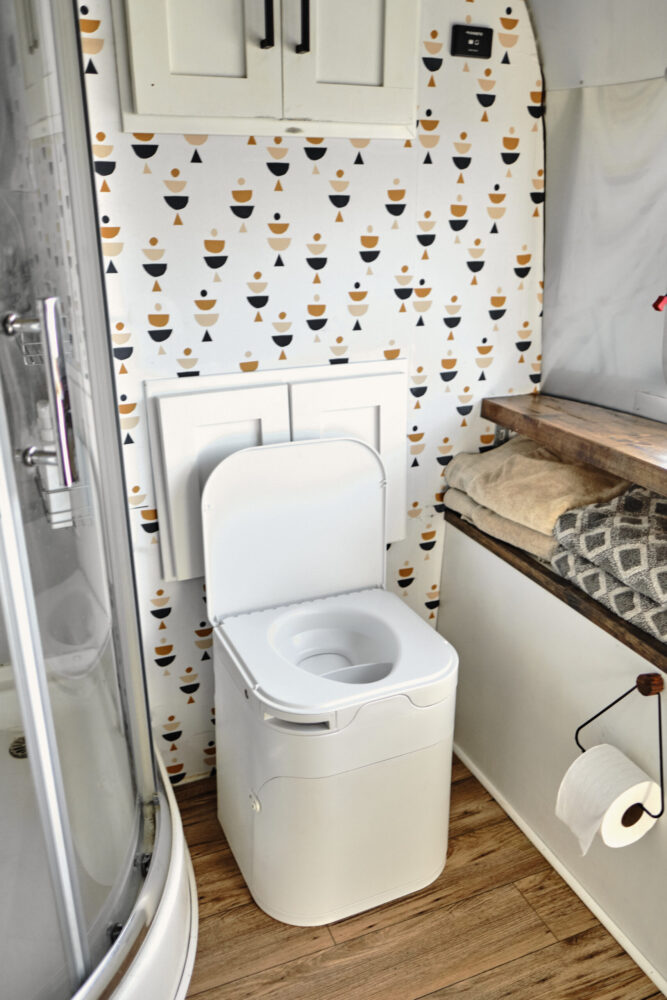Is an RV Composting Toilet in Your Future?
A composting toilet can help you dry camp for longer without worrying about filling your black water tank. Here’s how to pick a toilet model that works for your camper.
Different types of toilets require more or less interaction for results. And some may require access to electricity and water for best utilization or disposal.
Another part of your choice will be how much of a do-it-yourselfer you are, as well as what type of RV camping you are going to do. Let’s review the two types of RV composting toilets.
Self-contained toilets Vs. central composting
First, you need to determine if you will use a self-contained system or a central composting system.
- The self-contained system means that all the activity and composting will take place directly within the unit itself.
- A central composting system means you will have a toilet in your bathroom. But the actual waste removal is connected to a second system elsewhere in your rig.
How a Central Composting Toilet Works
A central composting toilet works with most central toilet waste removal systems already installed in most RVs.
This is when your waste is temporarily stored in holding tanks. Later, you release the waste into a dump station or RV campground waste system.
How does a self-contained Toilet Work?
A self-contained toilet still has a toilet in your bathroom. But because they are self-contained, they have the waste processing area inside the toilet itself. The nice thing is self-contained toilets are easy to install, have great portability, they’re economical, and easy to clean. They also help you cut back on water usage.
Consider your toilet capacity
First, you need to know the number of people that will be using your toilet on a regular basis. Most composting toilets can handle the waste liquids and solids of one or two people. But if you have a large family or regular visitors to your rig, you will need to consider the capacity of the toilet you want to select.
If you will not have alternative restrooms where you plan to camp, you need to select a large capacity toilet.
Will a Composting Toilet Fit in Your RV?
Before buying an RV composting toilet, get all the measurements of your bathroom. You need to know what size of toilet will be a perfect fit. There will be compartments you need to open, venting you may need to install, and more.
Measure the dimensions of your bathroom. Pay attention to the weight of the toilet. If you are near weight capacity for your rig, be aware of the additional weight you will be adding.
Here are measurement considerations you need to have:
- Toilet height, depth, and width
- Footrest height
- Drain hookup spot
- Depth required to remove drawer
- Vent outlet distance from right side and top
- Height to top of vent outlet assembly
Electric vs manual RV composting toilet
You also need to choose between an electric or non-electric manual composting toilet. A person’s RV camping style influences this big decision.
- For non-electric toilets, you need regular locations to safely and legally dispose of your composted RV toilet waste.
- Want an electric RV composting toilet? Most models require a 110-volt power supply. You need to know the amps and watts required to power it. And you may need a beefier RV solar electric power system or at least regular access to an electrical grid.
Even RVers who only camp with full hookups may opt for a non-electric toilet. These models are more economical than depending on electricity and the bill that comes with it.
For most composting toilets, the cost of compost mixes and compost bags for RV toilets is also a consideration.
How Composting Toilets Work
Electric and non-electric composting toilets work differently depending on the different manufacturers’ composting toilet system design. This may also influence your decision on which one to buy.
Non-electric toilets regular routine maintenance. This can mean daily rotation of the composting bin daily to remove liquid waste. It also means adding a composting material like peat moss or sawdust. Then at set periods, you will need to empty the drum.
Electric toilets need rotation too. But electricity can assist in that process with fans, vents, and other options to boost the waste decomposition process.
In both cases, you RV must have enough storage for the peat moss or sawdust materials that help get rid of sewage smell.
Choose a model that matches your lifestyle, meets the needs of your family size, and is one that you feel comfortable installing. You might also want it to be aesthetically pleasing.
One of the most popular options in the tiny house cabins, RV, and marine spaces is the OGO Compost Toilet. With its power agitation, patented urine diversion technology, built-in liquid sensor, and other available options, the OGO compost toilet is easy to use and easy to clean. No black tank is needed; plus, it has no odor, and it’s chemical-free.
Get tips from other RVers
One of the best parts about RVing is engaging with the community of traveling enthusiasts. iRV2 forums allow folks to chat with other RVers online, and get other perspectives on everything RVing, including products, destinations, RV mods, and yes, even toilet solutions.
Related articles:




